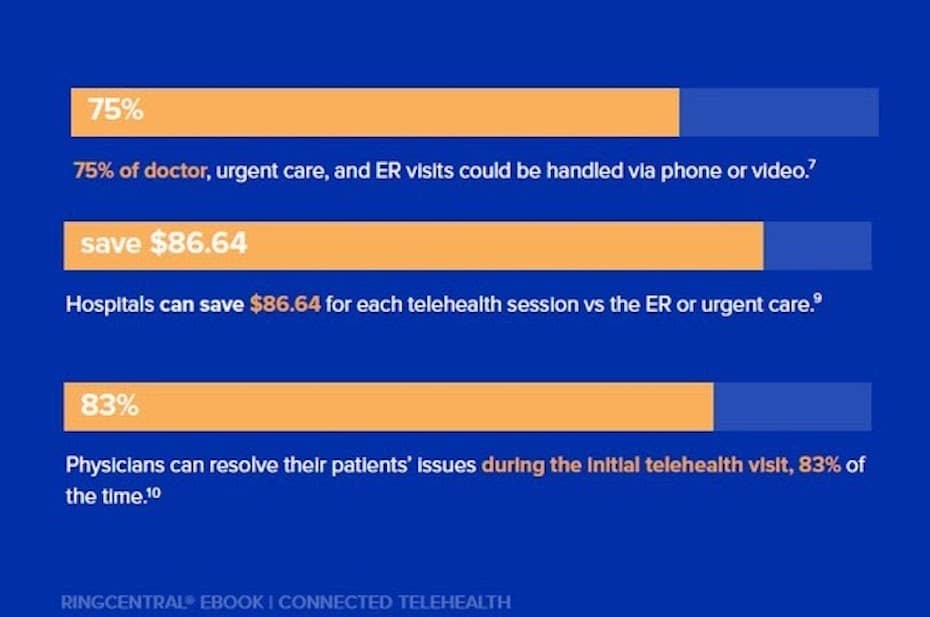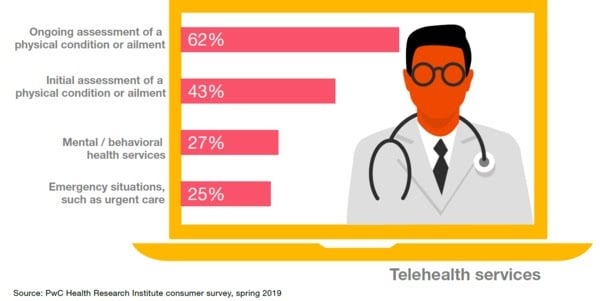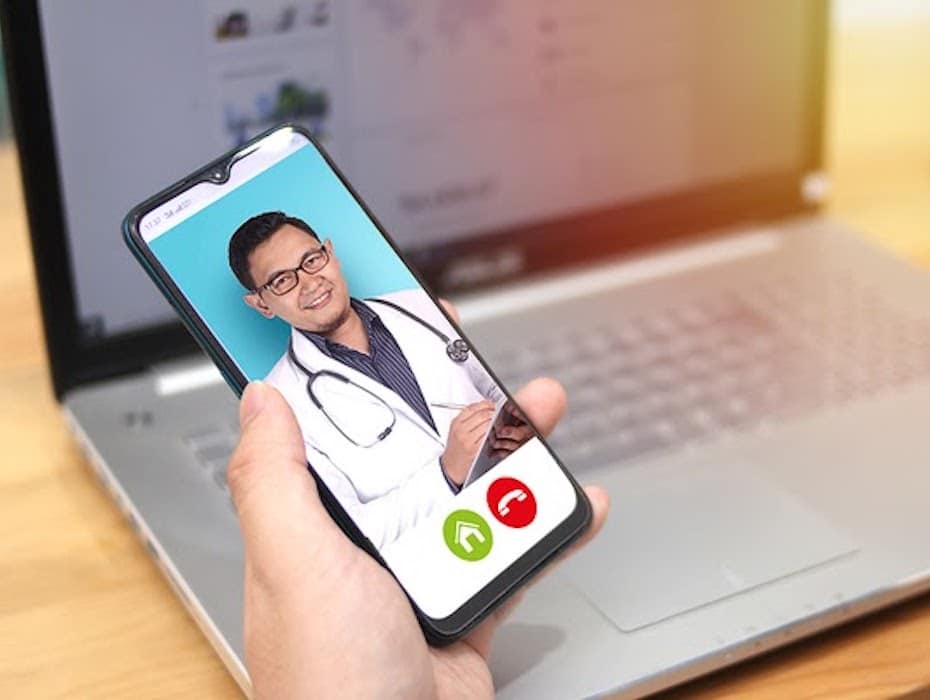Telehealth services represent an innovative way for providers to connect with patients. Moreover, they offer a tremendous opportunity; with telehealth services, healthcare providers can put new business models into practice.
View RingCentral’s Sample business models for successful telehealth services one-sheet
To understand the business value of telehealth services, consider the following statistics:

Source: RingCentral’s Connected Telehealth: Personalized patient care from anywhere eBook
To enable healthcare providers to get the most out of the business opportunities telehealth services have created, RingCentral is now offering RingCentral Office for free.
Virtual appointments
One of the most prominent business models that telehealth services enable is virtual appointments. With telehealth technology, providers can speak to their patients over the phone or hold video conferences. According to a 2017 Advisory Board survey, 77 percent of respondents indicated that they would consider seeing a practitioner virtually, and approximately one in five had already done so.
Regarding the surge in telehealth adoption since the recent pandemic, a 2020 McKinsey report reveals that 46 percent of patients are now using telehealth to replace canceled in-person visits, up from just 11 percent of patients who used telehealth in 2019.
Recent regulatory changes have actually encouraged healthcare providers to offer telehealth services. Assurance of reimbursement for offering telehealth appointments has now removed one of the previously significant impediments to the adoption of telehealth services for many healthcare organizations.
Partnering with employers to provide telehealth services
Many workplaces offer employee assistance programs; however, offering telehealth services to employers could be a new way to increase your revenue, reach more patients, and deliver value.
According to a recent PwC report, 49 percent of consumers with employer coverage said they are willing to use telehealth in place of an in-person visit. Those stating a willingness to use telehealth services indicate they would use them for the following types of medical services:

With telehealth technology, a partnership with employers creates a number of possibilities. Employees could connect with a provider through a kiosk, or they could use their tablet or smartphone to start a video conference. They could also pick up a phone and be routed through a contact center to an available provider.
Partnering with universities to provide telehealth services
While universities have health centers for students, there are long waiting lists to access services due to the relatively low number of staff members working at these centers. Telehealth services could ease that burden as well as boost revenue for providers.
Students could connect with a provider to receive the care they need from the convenience of anywhere on campus. Providers could increase their patient roster without having to commute, thus creating a win-win scenario for all involved.
Telehealth services may be especially welcomed by typical college-aged students who have grown up as digital natives. Whereas older patients may be a bit slower to adopt telehealth as an option, the college-aged demographic may consider telehealth to be a natural extension of the way they already interact with the world at large.
Dr. Ryan Spaulding, acting director of the KU Center for Telemedicine and Telehealth at the University of Kansas Medical Center, believes that using telehealth services helps to reduce some of the stigma associated with seeking medical care, including mental health care, for students. He notes:
“Mental health services are really scarce and hard to find…So, having that access on campus would certainly be a benefit that might not be there without telemedicine.”
Reaching rural patients
Another opportunity telehealth services provide is the ability to reach rural patients. Historically, rural patients have been underserved by healthcare providers. Faced with the prospect of traveling long distances at considerable expense in terms of lost wages, transportation costs, and inconvenience, many rural patients put off seeking medical care indefinitely.
According to research sponsored by NPR, the Robert Wood Johnson Foundation, and Harvard T.H. Chan School of Public Health, rural Americans are willing to use telehealth services. When those who have used telehealth in the past were asked the reasons for choosing telehealth services:
- 69 percent reported that telehealth was the most convenient way to get a diagnosis/treatment
- 30 percent reported that they could not see a regular doctor in person
- 26 percent reported that it was too hard to travel to a doctor or hospital
Telehealth technology connects rural patients with healthcare providers so that they can access convenient, cost-effective care. At the same time, it allows providers to add patients to their roster, increasing their opportunity for revenue growth.
Expanding your service offerings
Telehealth services make it easier to expand revenue-generating business models for your healthcare organization. Suppose you’d like to add a specialist to your roster, but the nearest specialists don’t live close enough to work at your practice. Telehealth services allow those practitioners to hold virtual appointments with patients.
When you can offer new services (such as appointments with specialists), you may find more interest from potential inpatients to join your practice. These patients might not have had access to those specialists previously, and now it’s easier for them to get the care they need.

Optimize staff utilization
Another of telehealth’s benefits is that you can optimize your staff utilization rate. Suppose you’re seeing patients in person, but due to no-shows, some of your staff members are sitting idle. Or, staff members might be quarantined, yet still healthy enough to work.
Telehealth services allow your staff members both inside and outside of the office to see patients virtually. When all of your staff is working, you can see more patients, which benefits the people you treat as well as your organization’s bottom line.
After-hours virtual care
Approximately three-quarters of visits to doctors, urgent care, and the ER could be handled either over the phone or through a video conference call. If your practice chose to offer after-hours virtual care, you could be tapping into a great need.
You could use dynamic call routing to enable after-hours virtual care. Dynamic call routing is based on answering rules, and with it, you can set rules that your phone would forward calls to any number in the world. After your practice closes for the evening, phone calls could be routed to designated on-call telehealth staff that can utilize the same telehealth technology at home as they do in the office. This creates a dual benefit of adding new virtual care services while enabling clinical staff to work from home.
Offering a patient access center
A patient access center is a contact center that allows patients to easily access healthcare staff and services and to navigate complex provider organizations. Here’s an example of how it works: Sheila is recovering from hip-replacement surgery, and she has a question to ask her physical therapist about the exercises she’s been prescribed. When she calls the patient access center, the agent connects her to the physical therapist, who answers Sheila’s questions.
By offering a patient access center, you deliver greater value to your patients. They sometimes have follow-up questions that don’t require an appointment. A contact center helps them get the answers they need, so continuity of care is preserved and you continue to earn revenue.
Leverage telehealth to build your practice
Telehealth technologies enable you to widen and deepen the scope of your practice. Why not explore ways to reach new patients and seize opportunities that were previously unavailable to your organization?
RingCentral can help you do just that. See how RingCentral cloud communications can transform your healthcare organization. Request a demo today.
Originally published Jul 30, 2020, updated Mar 17, 2021





